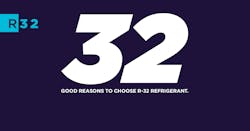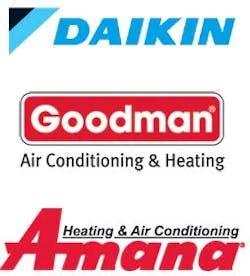The benefits of switching to R-32.
From contractors and engineers to regulators, distributors, and dealers, there’s no question that transitioning refrigerants in the HVAC industry affects a lot of different groups. Conflicting interests and differing motivations might make it seem like it will be hard to please everyone; but in this case, there is a decision where you can win. Let’s discuss why R-32 refrigerant is the easy choice when you take a closer look.
Survey results among residential HVAC dealers representing large, mid-sized, and small dealerships from multiple geographies in the U.S. and Canada offer promise that R-32 is an easy choice. To capture what dealers care about most when it comes to refrigerant transitions, we asked independent Daikin and Goodman dealers a wide range of questions, including their awareness of the pending refrigerant change, their anticipated challenges, and the importance of several refrigerant characteristics. Of the surveyed dealers, 90% chose “better energy efficiency” as the most or second-most important characteristic, and 70% preferred “allows for smaller equipment.” Knowing these were the most important factors for dealers, it wasn’t surprising that 81% of respondents were “very or extremely Interested” in the characteristics of R-32.
1. Energy Efficiency
- R-32 systems are up to 12% more efficient. Test data in Daikin labs of inverter compressor rooftops and water-cooled chillers found that full-load and part-load efficiency rating metrics can be improved by up to 12% by using R-32 instead of R-410.
2. Smaller Units
- R-32’s efficiency and capacity allow for lighter weight, more compact units in certain applications. R-32’s excellent thermodynamic properties provide HVAC engineers the opportunity to design systems that use less refrigerant to accomplish heat transfer compared to various blends. Moving less refrigerant through the HVAC systems allows for designs with smaller motors, smaller diameter piping and smaller heat exchangers to provide the same capacity and efficiency as blended refrigerants, which, in turn, can result in lighter weight and more compact units.
3. Global Standard/Accessibility
- R-32 is abundant and widely available. For many years, R-32 has been used as a primary component in R-410A refrigerant, and it is available from multiple suppliers.
- R-32 is a proven commodity. Deployed in over 100 million units around the world, it’s a proven performer as a replacement to R-410A.
4. Safety/Flammability
- More than 100 million units using R-32 are operating safely around the world, including chillers, packaged rooftops, VRF, PTAC, residential splits and window air conditioning units. This means throughout the world mechanical contractors and service technicians are already knowledgeable and skilled in R-32’s safe and effective handling. To further protect building residents and tenants, various national and international safety standards have been or are in the process of being modified to ensure HVAC equipment and systems are engineered with proven safety mitigations.
- R-32 is an A2L refrigerant and is difficult to ignite. R-32 requires about 100 times more energy to ignite as compared to propane, a commonly used heating gas.
R-32 not only addresses many of the concerns of HVAC dealers, it’s also creating a shift in the industry that is expected to lead to more business opportunities for dealers as consumers demand the latest technologies. Click here to learn more reasons why R-32 is a reliable, proven choice to drive better bottom-line business and help advance everyone in the HVAC industry.
Sponsored by:

